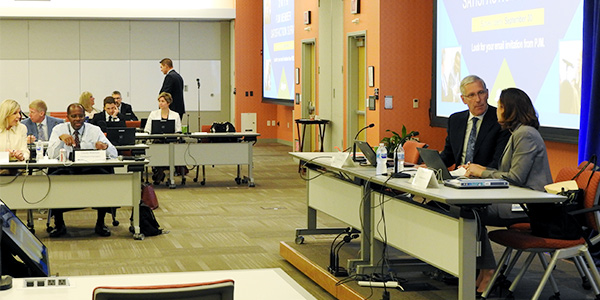By Christen Smith
VALLEY FORGE, Pa. — After months of wrangling, PJM and its stakeholders reached agreement Thursday on manual language detailing how the RTO will remove supplemental projects from its Regional Transmission Expansion Plan.
After American Municipal Power (AMP) and competitive transmission developer LS Power reached agreement with PJM on the manual language on Tuesday, Exelon crafted a friendly amendment Thursday that won support of most of the RTO’s incumbent transmission owners. (See related story, PJM, Stakeholders Strike Deal on Supplemental Projects.)
Supplemental projects are those that address local TO reliability concerns and are not required for compliance with grid criteria governing system reliability, operational performance or economic efficiency. The RTO does not approve supplemental projects but does study them to ensure they won’t harm reliability.
The Exelon amendment clarified that supplemental projects cannot be considered for inclusion in the RTEP base case during PJM’s modeling verification process, which generally precedes a submission window for competitive projects under FERC Order 1000. Sharon Segner, vice president of LS Power, described the verification process as the RTO’s version of “quality control,” implemented in order to assure the modeling assumptions used to solicit competitive projects are correct.
Segner said Exelon’s 23-word insertion in the last paragraph of section 1.3.4 in Manual 14B protects the integrity of the competitive process by preventing TOs from proposing supplemental projects designed to meet regional needs.
The paragraph states that “once PJM issues its preliminary RTEP models for verification of topology and dispatch prior to initiation of any preliminary RTEP analysis and quality control check in preparation for opening a proposal window, PJM will not consider for inclusion in the RTEP base case a subsequently submitted proposed supplemental project that would alleviate a violation identified in the proposal window.” (Exelon’s insertion is in italics.)
The agreements allowed members to finally vote on the revisions after four deferrals and eight months of discussion at special Planning Commission meetings. Six of 12 members of the TO sector endorsed the changes in the Markets and Reliability Committee vote, with four opposed and two abstaining. End-Use Customers, Electric Distributors and Other Suppliers gave near unanimous support to the manual change, which cleared by a sector-weighted vote of 4.55 to 0.45 (91%).
“These manual revisions are basically saying that when these Order 1000 windows open, PJM can consider projects that meet regional needs and regional drivers and can also consider supplementals that address these drivers to see if there’s a better regional solution,” Segner said. “The manual in and of itself is talking through what that looks like.”
LS Power had sought the manual revisions since the January MRC meeting, when PJM declined to implement stakeholder-endorsed language about planning transparency. Staff said the revisions were inconsistent with FERC rulings and would require the RTO to overstep its authority in the regional planning process. (See PJM Rebuffs Stakeholders on Supplemental Projects.) Spending on supplemental projects has tripled over the last 13 years, accounting for 62% of the submitted RTEP project costs since January 2017, according to an analysis from AMP. In 2018, AMP found, TOs added $5.7 billion in supplementals and just $1.5 million in baseline projects into the RTEP.
AMP said earlier this month that TOs have proposed an additional $3.4 billion in supplementals so far in 2019, exceeding the baseline total.
“We think we are at a better place than we were six months ago,” Segner told the MRC. “I’m talking about how to protect the integrity of the Order 1000 windows. So, we would say we are in a better place and there would be better protections in place than there are now.”
The revisions detail how PJM would alter the RTEP after siting authorities deny a permit for a supplemental project. The RTO has argued that it lacks the authority to remove such projects from the planning model and noted that a project can languish for years of litigation before a TO wins approval or abandons it.
The revisions state that if the denied application represents a final regulatory order, the developer must notify PJM. Staff would then review the “impacts associated with removing the project from the RTEP or continuing to include such project in light of such final regulatory order” and present its findings to the Transmission Expansion Advisory Committee.
“A project denied siting authority in a final regulatory order by the relevant regulatory siting authority will generally be removed from the RTEP base case as determined by PJM after discussion with the relevant transmission owner(s) or designated entity and vetting with stakeholders at the TEAC,” according to the new language.
The language also includes a path for TOs to dispute assumptions that a regional baseline upgrade will meet the needs of a proposed supplemental project.
Segner said that siting authorities will be notified when TOs stick with a supplemental project for which PJM has identified an appropriate regional solution — leaving it up to the states to decide what to do next.
She described PJM’s willingness to implement the changes as “the most important” outcome from the special PC sessions. When the vote results were revealed, many in the room — including most of PJM’s staff in attendance —broke into applause.
“That’s a victory for the stakeholder process, and we are at a better place,” Segner said.
Frustrated with the Process
Still, the process by which the issue was resolved left many stakeholders frustrated.
“This process has been very choppy and consumed an inordinate amount of time,” said Steve Lieberman, director of regulatory affairs for AMP, before agreeing that crafting language PJM would implement was the most important outcome of the special PC meetings. “That is a lesson that this membership learned, I think, in a hard way back in January. … I don’t know that we need to necessarily work that way all the time, but going into and having confirmation for a vote and both sides of the room agreeing with each other is a good thing.”




